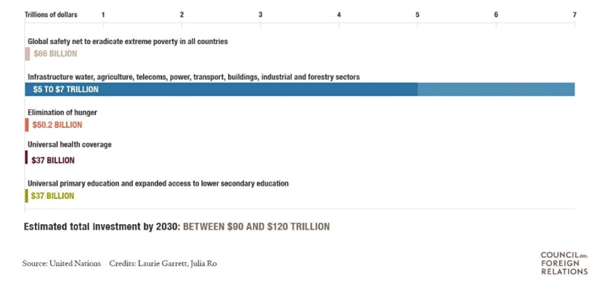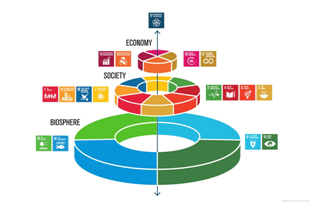Transform the world: how much does it cost?
Dr. Gilles Klein, 16 October 2017
Masses
Mobilize all stakeholders around the achievement of SDGs, governments, companies, and foundations. But also, mobilize those most interested in the cause, that is to say, the masses. The tasks of informing and education will not be the easiest. The SDGs implementation team at the United Nations, headed by Dr. David Nabarro, has set a target of December 2017 for at least two billion of the world's population to be informed and aware of the SDGs. Governments, companies, foundations, masses, it is a real challenge! The SDGs’ achievement is a universal challenge, so it is a matter for everyone: "To achieve these goals, each of us must take it on, governments, the private sector, civil society and every human being everywhere in the world”[1].
Challenge
The gamble may seem senseless as the actors to be mobilized are numerous. The bet may seem unreasonable as the financial amounts to be committed are enormous. Yet it is the tour de force which all tenants with precarious leases of the planet are invited if they want it to survive and this is a prescription for a cure. What planet do we want to leave to our children? For me, this question has long appeared a generality, a catchphrase, underlining the banality of a truism. It was just a lack of lucidity. The more I see my grandchildren grow up, the more it becomes obvious. It is time for everyone to proceed urgently to save what can still be saved.
Detour
To do this, we must assess the extent of the damage. Above all, we need to invent ways and means of financing that are more in line with the innovation economy and the challenges of the planet. But again, are questions to be asked in a blog dedicated to youth sport? Do we really have to worry about saving the planet to promote access to physical education, physical activity, and sport for young people in the world, mainly in the countries of the global South? For some, the detour is not worth the candle. After all, this is just sports. Enough talk! Just run, jump and throw. In my opinion, the challenge is worth the detour, precisely because SDGs are everyone's business.
Sahel
To recall the extent of the damage, let's take an example. To be able to do sport in the global South, it is necessary first to hydrate. Those who have not stayed in Niamey, N'Djamena or Nouakchott cannot understand what sport means in the Sahel countries. The Sahel? It is this stretch of Africa that makes the transition between the Saharan domain and its arid climate to the north and the savannas of the Sudanian area where rains can be abundant. In these regions, in the near future, the goal will be to hydrate, simply to stay alive.
Hot
For the children of West Africa, in Dakar, Ouagadougou or Bamako, soon for those of Southern Europe, the game is far from won. The study, published in the journal Nature Climate Change, revealed that by 2100, three-quarters of humanity are at risk of heat waves. According to this work, the determining factor in causing fatal heat waves is the combination of high temperature and humidity. Tropical zones are thus designated as the most affected, and West Africa is particularly vulnerable.
Scenario
The study sets out two scenarios. "In the first and worst case scenario, if global warming is not drastically reduced, 74% of the world's population will be threatened by these deadly heat waves; in the best scenario, by reducing global warming to 1°, the risks reach "only" 48% of the world population. But in one case as in the other, West Africa will not be spared”[2].
Paris
Of all this, we are all warned, if only by the press. The signing of the Paris agreement followed the Paris Conference on Climate (COP 21) of the United Nations Framework Convention on Climate Change. To forget this global effort, it would be necessary either not to follow the channels of continuous information, or to accompany the approach of the Republican American president who, against a backdrop of the defense of the coal-fired power plants, opposes the commitments of his predecessor to stem global warming.
Business
Let us forget the damage for a moment to think about business. Could the American President, who likes to exalt the sovereignty of the United States, be tempted by the tremendous volume of business that constitutes the achievement of the SDGs by the 2030 deadline? His first speech to the United Nations, held on 19 September, leaves no indication of any interest in this type of global challenge. However, the volume of business generated by the SDGs could be tempting. As shown in the following diagram[3], the estimated investment amount for the UN 2030 program is US $ 90-120 trillion.

Coordination
On 5 October, at the Lausanne seminar “Achieving SDGs through sport”, organized by the Swiss authorities, I mentioned a possible coordination of investments so that the international sports community collectively assumes Article 37 on the contribution of sport to SDGs[4]. I recalled the approach we had taken during the MDG era. By developing public-private partnerships in areas such as water infrastructure, agriculture, telecommunications, power, transports, buildings, industrial and forestry sectors, representing a volume of $ 66 billion, it is possible to finance universal health coverage - 37 billion US dollars - universal primary education and increased access to lower secondary education - 37 billion US dollars. I also showed that this coordination between SDGs and their funding could open new avenues to the financing of youth sport. We will return to this in the following episodes, drawing inspiration from some of the SDG's perspectives. That supplied by ECOHZ and the illustration of J. Lokrantz for Nitrogen put us on the way[5].

75%
Helen Clark allows us to measure the magnitude of the task. From April 2009 to April 2017, Helen Clark served as Administrator of the United Nations Development Program. She was the first woman to assume the leadership of the organization. She also served as the Chair of the United Nations Development Group. It is a committee that brings together the directors of all the funds, programs and departments specifically responsible for development issues. In 2015, when the 2030 program was voted, the UNDP official said that more than US $ 3 300 billion a year would be needed to implement the MDGs. We would have to beat the world record of investment. Indeed, the sum invested in 2014 for sustainable development was only 135 billion. But where can we find the remaining 75%?
Transition
They are to be found in the contribution of all stakeholders, be they States, companies or foundations. On the planet, we all row in the same boat, one beside the other. That said, there are disputes. We are now all forced to adopt the same vision of the future, included in the same global and multidimensional ecosystem, with its ecological, geopolitical, economic and social valences. Indeed, it is the great innovation initiated by the SDGs. In 2015, a journalist summed up the transition made possible by the 2030 program: "It marks the transition from goals for others (MDG targets to developing countries) to goals for all (SDGs)”[6].
Fallow
The MDGs launched in 2000 had the merit of providing a global framework for the international community to work on these development issues. As we have said, they had left fallow the issue of inequality, which concerns both North-South inequalities, but also inequalities within countries. Some regions of the world had been left out of development: this was the case in Africa, but also in South-East Asia. Unlike the MDGs, SDGs are universal, which will force all countries around the world to participate and ask how to achieve these goals. Indeed! How? Let us take an example of universal scope, in the sense that it concerns the totality of the women and men of this planet.
Forests
One of the seventeen (17) SDGs interests each creature at the highest level. Even the American President, his five (5) children and eight (8) grandchildren, even his typical voter, this religious white American, over 45 years old, living in a small or medium-sized city, of $ 50,000 a year, are very much concerned. This is the fifteenth ODD: Sustainable forest management, combating desertification, halting and reversing the process of land degradation and halting the loss of biodiversity.
Green
A few sentences will suffice to recall the stakes of the achievement of this SDG. Terrestrial vegetation plays a crucial role in climate change. Deforestation contributes to the increase in temperature. The role of forests is crucial to limiting greenhouse gas emissions. Forests absorb and store CO2, each year the forests absorb nine (9) million tons, ie 20% of CO2 emissions. One billion six hundred million people live in and from the forest. The disappearance of forests is programmed if nothing is done. The United Nations and the nations are mobilized. In 2014, the summit on deforestation. In 2015, the Paris agreements. Governments, businesses and indigenous communities decide on common objectives.
Oxygen
Reduce deforestation by 50% by 2020 and halt it by 2030 and aim for resilience to CO2. Since 2011, the World Bank has spent 10 billion US dollars combatting deforestation. Comprehensive resilience to CO2 involves spending several hundred billion dollars. At least 1000 billion US dollars a year by 2050. The public sector is not able to finance this. Private sector engagement is essential. This entails the need to create the necessary tools to raise funds. Somehow green US banknotes to save the green of the planet. If the reduction in CO2 is essential for the planet to continue to breathe, oxygen is essential for everyone's breathing. The transition is easy, you will think! This brings us back to the oxygen necessary for the sport of youth. And if we were inspired by processes designed to be resilient to CO2 to generate money that could develop youth sport so that it could breathe better. Forests, physical education, youth sport? Who will pay?
Next: Monday, October 30, 2017 - Transforming the world: detour by Lausanne
[1]UNESCO (2017), L’éducation en vue des objectifs de développement durable : objectifs d’apprentissage, ISBN 978-92-3-200116-0, page 10.
[2]Jeune Afrique (2017), En 2100, 74% de la population mondiale risquent de mourir de chaud, 23 juin 2017 à 13h05 — updated 23 June 2017 at 15h15, by Élodie Descamps.
[3]United Nations, Council on Foreign Relations, Credits Laurie Garett, Julia Ro, cited by Eisenstat, A. et Traub, D. The Future of Impact Investing: Funding Social Innovation
for Sustainable Development,in CSR Index 2017, Edited by:
Matthias Vollbracht & Roland Schatz page 61.
[4]Coordination that would involve collegial governance of the Sport for Development and Peace sector on which we will come back.
[5]ECOHZ,https://www.ecohz.com, particularlyhttp://bit.ly/2xyaI5A
[6]Libération (2015), L'ONU adopte un programme pour changer de monde, by Clarisse Chick (http://www.liberation.fr/auteur/15874-clarisse-chick) — 25 September 2015 at 19:07


No comments:
Post a Comment